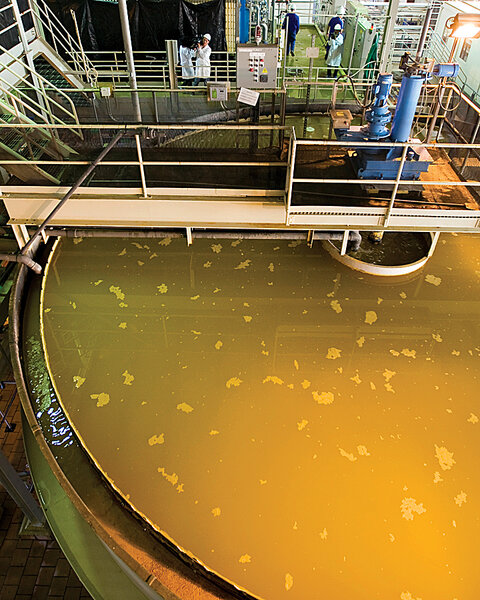The cost of being the world's No.1 uranium producer
Loading...
| Astana, Kazakhstan
If you make a toxic mess under one of the most isolated parts of the planet, does it matter if you don't clean it up? Does it make a difference if that mess will be there for thousands of years?
Scientists are asking those questions as Kazakhstan has steadily risen to become the world's No. 1 uranium producer, surpassing such nations as the United States, Canada, and Australia, which require more cleanup.
Rather than employing miners to haul rock up to the surface, mine operators in Kazakhstan have embraced a newer – and generally cleaner – process by which a chemical solution is injected down a pipe to dissolve the underground uranium deposits and then is sucked back up to the surface.
This in situ leach (ISL) method avoids making a mess above ground, but leaves toxic levels of heavy metals in the ground water. In the US, companies using the method have tried for years and failed to return ground water to its pre-mining state.
In Kazakhstan, a country that has seen the disastrous effects of the Soviet Union's use of nuclear testing and waste disposal, officials with the state-owned uranium company, Kazatomprom, express no concern about the legacy of its rapidly expanding use of ISL mining. They argue that natural processes will clean the mine site.
Scientists studying the effects of ISL doubt how quickly mine sites can self-cleanse. This uncertainty appears to be little known to both Kazakhstan's nuclear industry and fledgling environmentalists.
In the near term, the stakes do not appear high: Kazakhstan's uranium mines are mostly located in deserted areas of an already sparsely populated country. But as the US learned in its own uranium-rich Southwest, population patterns and land use can change, potentially deferring an expensive cleanup or rendering some water resources unusable.
"Kazakhstan is a growing country and the pollution could persist for up to thousands of years, and you just don't know in the future if people might live in the area," says Brian Reinsch, an environmental scientist researching ISL remediation methods in Kazakhstan.
It could take natural processes between tens to thousands of years depending on the conditions at each mine site, says Dr. Reinsch. Active remediation efforts can shorten the time substantially, removing the uncertainty that comes with such longtime horizons.
Drinking water
ISL mining in many parts of the world involves some treatment of the solution that is left behind in the ore-bearing aquifers. If untreated, the solution could contain arsenic and cadmium at levels thousands of times higher than drinking water standards, says Gavin Mudd, an environmental engineer at Monash University in Australia. Arsenic can also be absorbed by plants, leaving the water unusable for irrigating crops.
Over time, the contaminated water will gradually spread laterally – often at paces as slow as a meter per year – beyond the mining site. ISL mine sites are chosen in areas where there are barriers like clay above and below the ore deposit to prevent water from seeping vertically into new aquifers with higher quality water.
But the clay layer is not entirely continuous, nor is it certain the mining acid wouldn't dissolve the clay, according to Reinsch. Furthermore, the mining process treats the ore-bearing aquifer like a pincushion, drilling holes all over the area. These are plugged up. But there is uncertainty about the spread of contamination over the long haul.
"Even if we were monitoring for five or 10 years, that's nowhere near enough. We need literally hundreds of years of data of watching these sites to show yes, they are stable," says Dr. Mudd.
Kazatomprom officials say they don't share this doubt. "It's the other way around," says senior manager Kalilallo Baytasov, who notes companies must set aside funds in case cleanup is needed. "We extract … uranium from the formation and send it to atomic reactors, so we are actually purifying the subsoil from heavy metals."
'Unique capability of self-restoration'
In 2012, Kazakhstan accounted for 35 percent of global uranium production, garnering $1.54 billion in uranium sales for Kazatomprom. China bought more than half of it.
The company claims that "it has been unambiguously proved" that southern areas of Kazakhstan have "a unique capability of self-restoration."
But Susan Hall, a geologist with the US Geological Survey, says: "When I question them about what kind of work they've done to prove this concept, I don't get a clear response."
Jerry Grandey, a former mining executive, experienced in international ISL projects argues that active remediation may not be required here given the water quality. "Generally, the water in Kazakhstan is unsuitable for most uses including drinking water and agriculture," he says. Nevertheless, he says, the water should be monitored. He adds, cleanup is more important in the US, where the surrounding water often has agricultural and industrial uses.
Some US wells have been cleaned enough for the water to be deemed fit for its pre-mining uses.
But no site in the US has been entirely returned to pre-mining conditions, says Dr. Hall. The difficulty has led to some soul-searching among regulators, she adds, who will ask: "Would natural processes just take care of it? Is it a wasted effort?... We don't have the data to know."
Out in the Kazakh desert, the French uranium company AREVA is funding Reinsch to find a better way. He is planning to send food down the mine pipes to more quickly grow the population of natural microbes that help clean the sites.
Hall cautions that such bioremediation sometimes only works temporarily.
But Reinsch is optimistic, saying that if the technique works, Kazakhstan has an opportunity to show the world how it's done: "If you ... can reduce the risk significantly, then why not? It's kind of like what your mother told you: Clean up after yourself."
• Ben Arnoldy traveled to Kazakhstan on a trip organized by the International Reporting Project.







